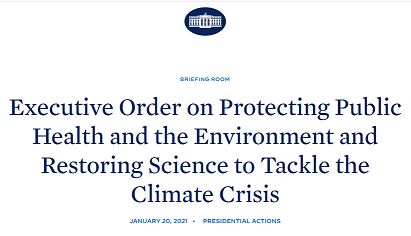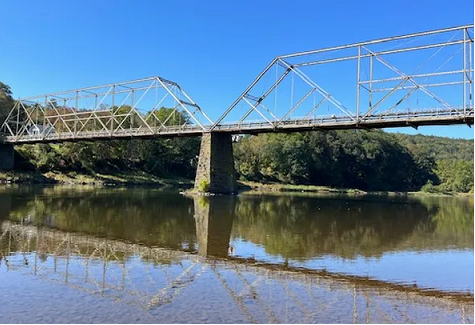
Fracking: The Stress of Being Surrounded
March 7, 2021
How the Salvation of NYC Drinking Water Can Be a Model for Saving the Planet
March 19, 2021Biden’s executive order “Protecting Public Health and the Environment and Restoring Science to Tackle the Climate Crisis” (“Restoring Science”), issued January 20, has received bafflingly little publicity. In effect, it orders federal agencies to take out the regulatory trash left by the Trump administration.. It goes so far as to specifically enumerate some of what it considers to be trash:
- EPA rules regarding emissions in the oil and gas sector, issued last September, that lifted emissions standards for broad segments of the industry, and as described by Harvard Law, “re-interpret the Clean Air Act to attenuate EPA’s authority to set pollution control standards generally”
- The Keystone Pipeline permit
- Arctic Refuge oil and gas leasing
(see more details below)
Biden’s order “Modernizing Regulatory Review” (“Modernizing”) has been much better publicized (the title of this post is a tip of the hat to a Huffington Post article about it), although it does not by itself, unlike “Restoring Science”, have the power to initiate any rulemaking action. However, it does make sure that any new regulations proposed, or amendments of regulations, will actually make it past OMB review by its sub-office OIRA (Office of Information and Regulatory Affairs), whose approval is required before any federal regulation can be published as final.
So “Restoring Science” instructs agencies to review all rules and actions implemented during the Trump administration and propose amendments or elimination of those rules, and in some cases issue new rules—depending on their consistency with principles of science, environmental and social value; “Modernizing” instructs OIRA, the office tasked with reviewing and approving regulatory proposals, to make adherence to those principles the criterion (in addition to consistency with law) for approving proposed regulatory actions.
Together, the orders form one tool, a tool designed to make sure that federal regulations act to protect human, environmental and social health, in a long-term as well as short-term framework, as determined by scientific evidence, not just corporate bottom lines, as has all too often been the case in the past.
And together, they comprise an invitation to environmental activist organizations, such as DCS and its allies, to review the list of federal regulations that we have all been butting our heads against for decades, and share with the agencies that have issued them our knowledge of the ways in which they violate the principles the Biden orders lay out, and why they should be changed or eliminated. Agencies are tasked with coming up with lists of rules they intend to work on by April 20 of this year, so if you want to contribute, now is the time to start.
Below is some information about what the two orders do, how they work together, and why, if you care anything about the environment, you really want to know about “Restoring Science” as well as “Modernizing.”
You can also read the orders themselves here:
WHAT ARE OIRA’s POWERS OF REVIEW AND WHY SHOULD YOU CARE?
“Modernizing” deals with the process of regulatory review by a sub-office of the Office of Management Budget, OIRA.
OIRA does not make regulations. Regulatory agencies, the ones that are tasked with action in “Restoring Science”, propose regulations in keeping with federal law. They create the initial drafts; they collect feedback; they amend the drafts; they propose final rules. OIRA does none of that, though it can actually suggest ideas for new regulations to agencies. But it can’t force them to act on those ideas, and fundamentally, it’s an editor, not an author.
But OIRA doesn’t just make suggestions: its approval is needed for proposed rules to be formally adopted and published. So if a regulatory agency can’t make OIRA happy with its proposed rules, they will not go into effect. And if it can’t get a particular part of a regulation past OIRA, that part will have to be amended or taken out. That’s why “Modernizing” is so important.
The criteria OIRA looks at when approving, requiring amendment of or denying regulations are 1) consistency with federal law, and 2) consistency with whatever executive order is in force at the time of review (which has changed over time with different presidents).
Under any administration, OIRA is supposed to make sure that the costs of a regulation do not outweigh its benefits. And historically, “costs” have been measured largely in dollars, and generally in an easily measured, short-term, narrowly focused sense — i.e. corporate bottom lines. Created by Reagan, OIRA became the conduit through which corporate lobbyists could make sure that regulations stayed out of the way of profits. That’s why Biden’s new order is so important. The list of criteria it gives OIRA on the basis of which to make judgments about regulations are the degree to which they promote “public health and safety, economic growth, social welfare, racial justice, environmental stewardship, human dignity, equity, and the interests of future generations.” Money is still in there, sure, but only as one element in a long list of other, more holistic considerations, and second to public health and safety.
All of this has the potential to be immensely important. But only if OIRA receives some valuable and effective new regulations to review. That’s why “Restoring Science” is the executive order that contains the real red meat.
WHAT ARE THE AGENCIES ORDERED TO DO TO PROTECT PUBLIC HEALTH AND RESTORE SCIENCE?
Like “Modernizing”, “Restoring Science” starts by setting out a list of policies. In light of these policies, the heads of regulatory agencies are ordered to “immediately review and take action to address the promulgation of Federal regulations and other actions during the last 4 years that conflict with these important national objectives, and to immediately commence work to confront the climate crisis…”
The list of policies in “Restoring Science” is more extensive, more specific, and has more of an emphasis on environmental concerns than those articulated in “Modernizing”. In fact, it reads kind of like a composite of phrases from environmental organizations’ mission statements:
To listen to the science; to improve public health and protect our environment; to ensure access to clean air and water; to limit exposure to dangerous chemicals and pesticides; to hold polluters accountable, including those who disproportionately harm communities of color and low-income communities; to reduce greenhouse gas emissions; to bolster resilience to the impacts of climate change; to restore and expand our national treasures and monuments; and to prioritize both environmental justice and the creation of the well-paying union jobs necessary to deliver on these goals.
Note that the only mention of money considerations in this list is “well-paying union jobs.” No corporate bottom lines here.
The heads of agencies are ordered to submit a preliminary list of actions they propose taking in response to the executive order within 30 days (a deadline now well past as of this writing), if such actions would be completed by December 31 of this year. They are ordered to submit an updated list of such actions, to be completed by the end of 2025, within 90 days – which makes April 20 the next deadline. That means that if any of you have ideas about specific regulations you think some agency should be amending or rescinding, now would be a good time to make your voices heard.
SPECIFIC REGULATIONS FOR WHICH REVIEW IS MANDATED:
Unlike “Modernizing”, “Restoring Science” lists specific regulations that the administration thinks should be addressed, along with deadlines by which it wants preliminary suggestions. Go to the link to see the whole list, but a few likely to be of interest to readers of this blog are:
Reducing Methane Emissions in the Oil and Gas Sector: “Oil and Natural Gas Sector: Emission Standards for New, Reconstructed, and Modified Sources Reconsideration,” 85 Fed. Reg. 57398 (September 15, 2020), by September 2021.
Proposing new regulations to establish comprehensive standards of performance and emission guidelines for methane and volatile organic compound emissions from existing operations in the oil and gas sector, including the exploration and production, transmission, processing, and storage segments, by September 2021;
Place a temporary moratorium on all activities of the Federal Government relating to the implementation of the Coastal Plain Oil and Gas Leasing Program, as established by the Record of Decision signed August 17, 2020, in the Arctic National Wildlife Refuge. The Secretary shall review the program and, as appropriate and consistent with applicable law, conduct a new, comprehensive analysis of the potential environmental impacts of the oil and gas program.
IN OTHER PORTIONS OF THIS ORDER, “RESTORING SCIENCE” ALSO:
- Revokes a whole litany of Trump’s executive orders and actions, of which the best known is probably the one granting the Keystone Pipeline permit.
- Mandates developing an accounting for the social costs of greenhouse gas emissions, which it specifies to include ecosystem services and human health, among other items.
- Establishes a working group to create such accounting, specifies its membership and gives it deadlines.
Both orders are worth a read. They’re not that long.




